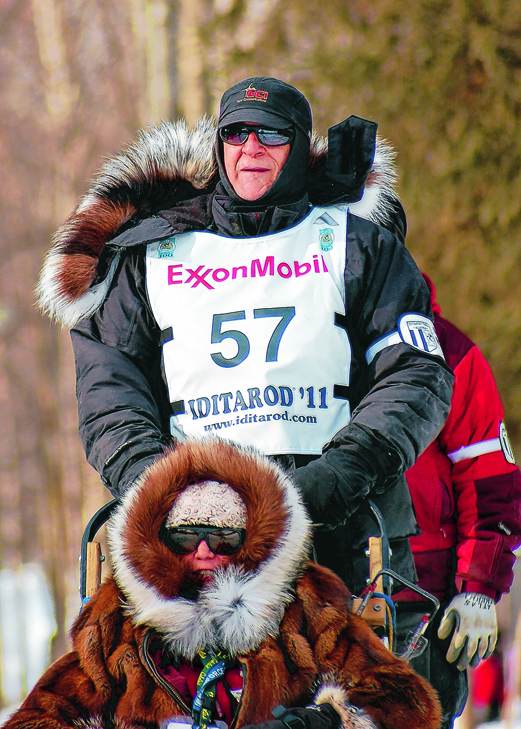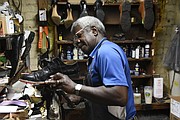Saliva crystalized into frost on the huskies' chests. Harness latches iced shut and tuglines froze rigid. Water in bowls solidified in minutes. And on this February practice run for the Last Great Race on Earth, the morning low of 19 degrees was almost 80 degrees warmer than it could be at the 2015 Iditarod for which these sled dogs are training.
"These dogs, their instinct is handling cold weather, running and pulling," says Jim Bardoner, a Chattanooga musher who faced temperatures of 60-below-zero when he competed in the 2011 Iditarod. "It's just what they do and they do it well."
Bardoner, Bryan Sisk and Steve McBryar along with 10 adult huskies and nine puppies make up the Southeastern Sled Dogs.
Competitive dry land mushing is a new, but growing sport in the South. Races, with competitors using custom-wheeled sleds, have sprouted up in Virginia, Kentucky and even Murfreesboro, Tenn. For those looking for a more traditional (and frigid) experience, several dog owners in states like Montana will lease teams to novice mushers who can't keep their own kennel where they live. Bardoner leased such a team on his 2011 attempt and he knows of other men in Atlanta or other Southeastern cities who have done the same.
But in terms of a full team training for the Iditarod based in the South, Bardoner and Sisk believe they are the only ones. Beating out a Flagstaff, Ariz., team by a fraction of a degree latitude, they may be the southernmost team in the United States. They are not, however, the southernmost team in the hemisphere. In what seems like a bad sequel to the bobsled film Cool Runnings, Jamaica has its own dry land dog sled team.
When the 2013 Iditarod begins March 2, a Jamaican team will be joined by a mixture of international mushers from Russia to Brazil, Canada to New Zealand. U.S. teams competing will represent at least seven states, with rookie racers taking on longtime veterans. Bardoner says the appeal of his sport is the same as the draw of taking a hike on Lookout Mountain or paddling down Chickamauga Creek - getting out into nature. Once on a sled run, he and his team passed right through the middle of a herd of elk bedding down for the night. "You can go places and see things you wouldn't any other way," he says.
But all of the mushers know the remoteness of their adventure can quickly turn deadly. "It's so cold it just saps the energy right out of you," says Bardoner, who endured temperatures at 60 degrees below zero on his 2011 attempt. "There are no cell phones. There's no AAA. No one's coming to rescue you."
Bardoner made it about 500 of the 1,100-mile race before withdrawing. He tore up his shoulder, nearly broke an arm and felt the first signs of hypothermia before waving the white flag at a check station. If he completes "The Last Great Race on Earth," in 2015, he will be the first Tennessean to do so, and after turning 65 this June, he could be the oldest first-time Iditarod finisher.
"I may be the last one across and have to put out the lantern," he says, referring to the tradition of the last musher extinguishing a light at the finish line. "That's OK as long as I finish."
Pooch Powered
To understand dog sledding, whether in Tennessee or tundra, you have to start with the dogs.
"The races really are more about the dogs than the mushers," says Bardoner. The first thing you notice about the team is the dogs' surprising size - or lack thereof. In Jack London's book Call of the Wild, the main character is Buck, a 120-pound St. Bernard-Collie mix that adjusts to life on a sled team. Most of the dogs used in modern sled teams are half that size at 50-60 pounds.
The Southeastern team uses Alaskan huskies, which are a mix of the heavier Siberian Husky and a long-legged dog such as a hound, pointer or setter.
But remember the cliché about judging the size of the fight in the dog rather than the size of the dog in the fight? That also applies to dog sledding.
Teams of dogs similarly sized to the Southeastern team have pulled school buses. Even after their training run where the dogs pulled Sisk on a four-wheeler for 13 miles, they still tugged on the lines threatening to slide the ATV forward - even with the wheels locked by the brake.
Imagine how excited your dog gets when you get out his leash. Now add generations of breeding for energy and a roaming, wolfish instinct hardwired into the canine brain. Then multiply it by 10 or 12 dogs and that's a lot of pulling power.
"When they take off on a 12-dog team, you better hold on or you won't be going with them," Bardoner says.
Canine Chemistry
In Prentice Cooper, as the men uncrated and harnessed the dogs, that energy turned into puffs of steam from the dogs' howling, yelping and barking. The anxiety manifested anywhere from the constant whines and chortles of Leo, the largest and most talkative on the team, to the quiet panting of Scrat, the veteran Alpha and lead dog. Once they were in the harnesses attached to the ATV Sisk rode for training, all of the dogs except Scrat began jumping and pulling forward, as if they were reindeer about to lift Santa's sleigh. Scrat, the Iditarod veteran and the dog that most closely resembles the classic husky look, laid down in place but popped up and pulled as soon as Sisk called "Hike!"
Sisk, a Rossville resident, says each team member has his or her own distinct personality, needs and skill level. As the musher, it's his job to arrange the dogs to get the most out of the team. "You get personalities that clash some times, just like people," he says.
As the dogs were being harnessed, Nona chewed through the wiring on their trailer's taillight. "You've got two nervous chewers next to each other," Bardoner pointed out.
He said getting to know each animal and helping them get to know him, is one of the best parts of the sport. "They really trust you," Bardoner says. "It's a much closer relationship with the dogs than if you just feed them and take them for a walk."
When you are pushing through 1,100 miles of frozen rivers and snow-covered mountain passes, that relationship and understanding of each other can mean the difference in life and death.
Human Helpers
The other half of the team is the human mushers, who are in some aspects, the weakest link.
"The dogs are the easy part," says Sisk. "We've learned so many lessons." Most of that learning has to be crammed in while the temperatures are cool. Sisk and the team don't take the dogs to train if the temperature is above 50 degrees because the dogs can easily overheat. So in the winter, they train three or more mornings each week.
The ATV, shifted into second gear, provides hefty resistance for the dogs to pull - and quite a sight for the bewildered drivers who pull over to yield to the team.
While the four-wheeler rig may look like something more suited for the Redneck Olympics than the Iditarod, it's the same method many of the teams around the world use to train. "Even the people in Alaska start on dry land," Bardoner says. "They have to be trained up before they run on the snow."
The way the teams are trained has changed drastically over the years. In Call of the Wild, London details the drivers' beating and whipping of Buck and the other dogs.
Modern mushing has dropped tools like the club and the whip. The International Sled Dog Racing Association makes all mushers agree to "no cruel, inhumane or abusive treatment of any dog, through deliberate action or inaction, through knowledge or ignorance, with or without implement."
An emergency room physician, Bardoner applied to volunteer at the Iditarod acting as a medical assistant for mushers. When he told the staff he didn't have any experience working with animals, he was sent to the radio room to help with communications.
"They said we don't need doctors, we need vets," he says.
To watch the dogs train visit getoutchattanooga.com


